The OCZ Vector 180 (240GB, 480GB & 960GB) SSD Review
by Kristian Vättö on March 24, 2015 2:00 PM EST- Posted in
- Storage
- SSDs
- OCZ
- Barefoot 3
- Vector 180
SSD Guru: The New OCZ Toolbox
During the past couple of years we've seen a big push for better toolbox-like software for SSDs from nearly every major vendor. The reason lies in the ability to differentiate because SATA 6Gbps has already been saturated for so long and being substantially different in the performance department has become practically impossible (although that will soon change with PCIe and NVMe). As a result, the SSD manufacturers have had to seek for other opportunities that can increase the value for the customer and software has lately become one of the key aspects in doing so. (It is worth noting that the motherboard industry went through the same process, whereby most motherboards in a price bracket had a flat feature set and software became a differentiating factor. -Ian)
The old OCZ Toolbox
OCZ has had a toolbox for as long as I can remember, but to be honest it looked more like an engineering tool rather than something that was aimed for the end-user. It did have the critical functionality (firmware update, secure erase, SMART data), but given what the competitors have put out to the market it was certainly lacking in both features and usability.
I guess my original Vector is in need of a firmware update
Today, along with the Vector 180 release OCZ is launching its fully redesigned toolbox called the SSD Guru. The overall design of the SSD Guru is much more user friendly and, as we've seen in other toolboxes, the welcoming screen already includes all the essential information about the drive so the user doesn't have to dig through the different tabs to find the important data.
The SSD Guru is available as both Windows and Linux installers as well as a separate bootable tool for Mac users. All Barefoot 3 based drives are supported along with the RevoDrive 350, but the older Indilinx and SandForce based drives are not (although you can still use the old toolbox if you wish).
The 'Tuner' tab includes two separate functions: SSD and OS Tuner. The SSD Tuner allows the user to issue a TRIM command to the drive to erase unused blocks to improve performance (although this should be unnecessary if you are running an OS with TRIM support) and it also includes a tool for increasing the over-provisioning for further performance gains.
The OS Tuner includes a few basic OS features that can be disabled for higher performance and/or capacity. By default the SSD Guru does nothing, but there are three preset options (reliability, performance and capacity) that you can choose from to optimize the OS. Different settings will be disabled based on what you choose (e.g. capacity option only disabled hibernation, whereas reliability disabled all four listed in the image above), although you can also customize the settings and disable what you see fit.
The maintenance tab has the common firmware update and secure erase functions that were also present in the old OCZ toolbox. The SSD Guru will also show a notification on the desktop if there's a newer firmware available.
The SSD Guru also supports logging, which can be a useful feature if you ever have issues with the drive and need to contact OCZ's support.
One feature OCZ emphasized is the ability to save a 'support package' that can then be sent to OCZ support if the drive isn't operating properly. The file includes a brief overview of the system with the necessary information that may be needed by the support staff for troubleshooting.
The one last cool feature of the SSD Guru is its SMART data monitor. Instead of just listing all the values like toolboxes usually do, OCZ has included three key icons that help the user to understand the purpose of each SMART value. While enthusiasts will understand the data without the keys, I still think it's a nice addition and something that at least slightly differentiates the SSD Guru from what is already out on the market.
The version that is being released today has all the core features that you would expect from a toolbox, but none of them are truly unique. Obviously, being a 1.0 release, OCZ only decided to include the most critical features to build the foundation for SSD Guru and the company already has a list of features that are under consideration for future updates (e.g. benchmarking tool). That said, I think the SSD Guru was a necessary move from OCZ in order to be considered a tier one OEM because it's an area where the company has certainly been lacking compared to the competition. I can't say the SSD Guru is special, but in the end the purpose of a toolbox is to provide easy access to the most needed SSD tools and the SSD Guru certainly does that.


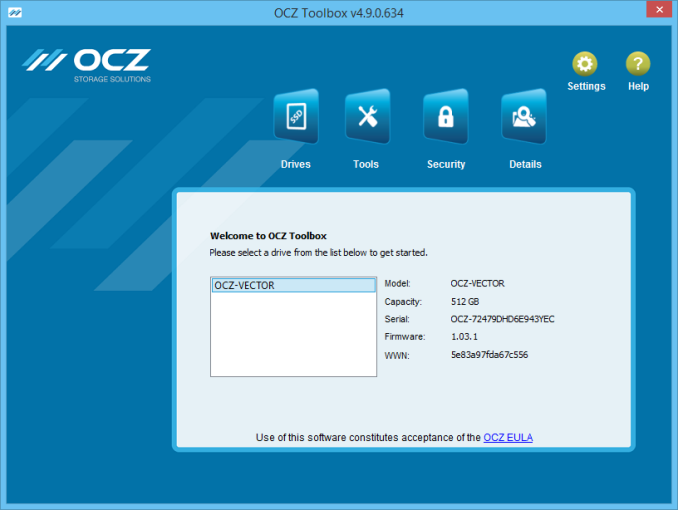
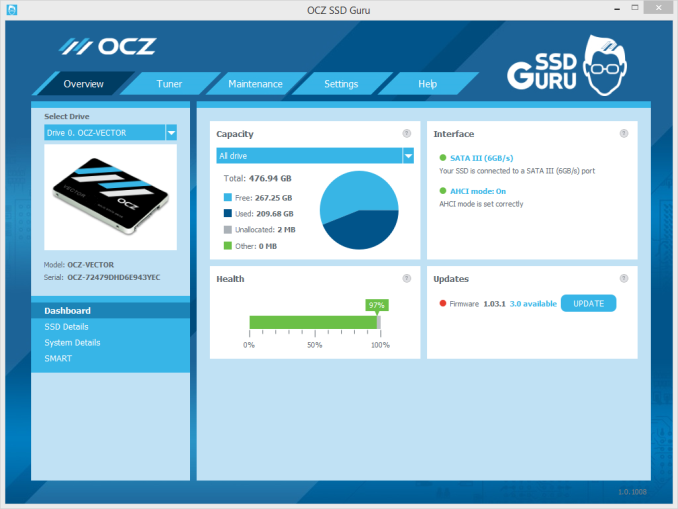
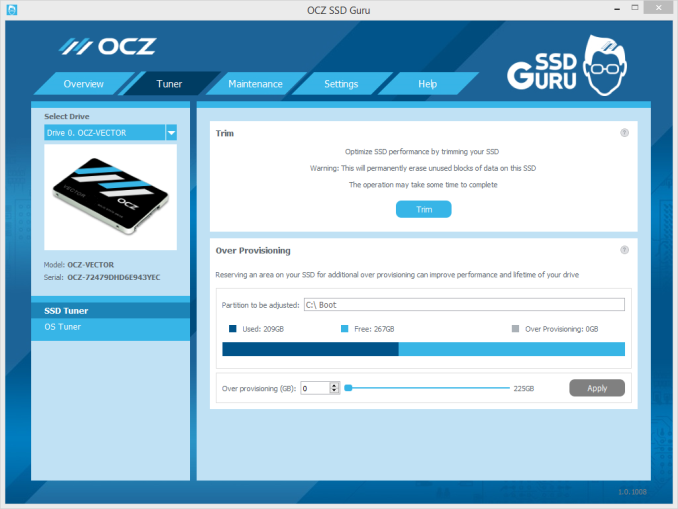
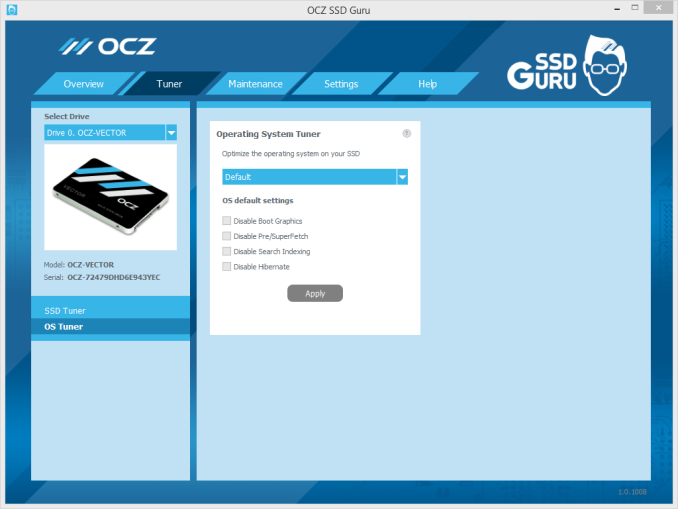
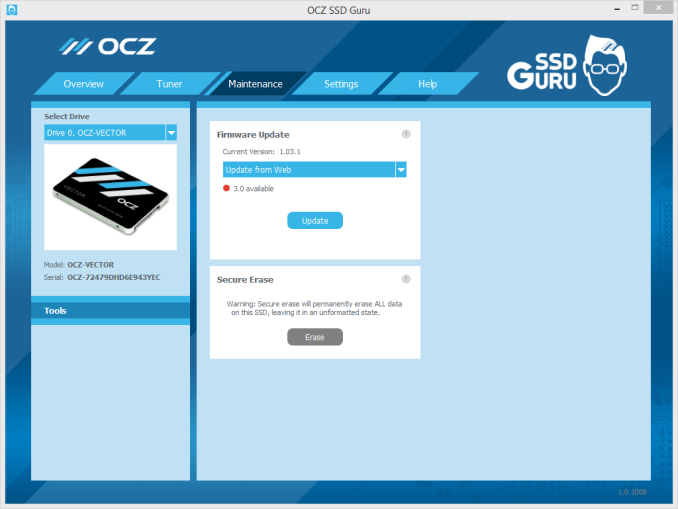
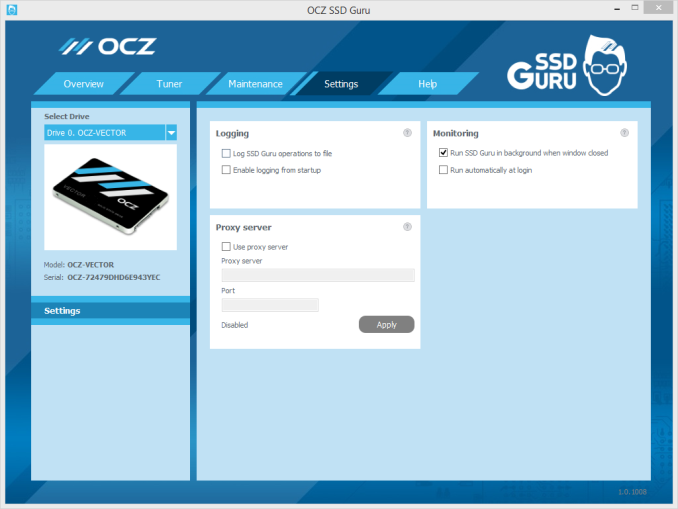
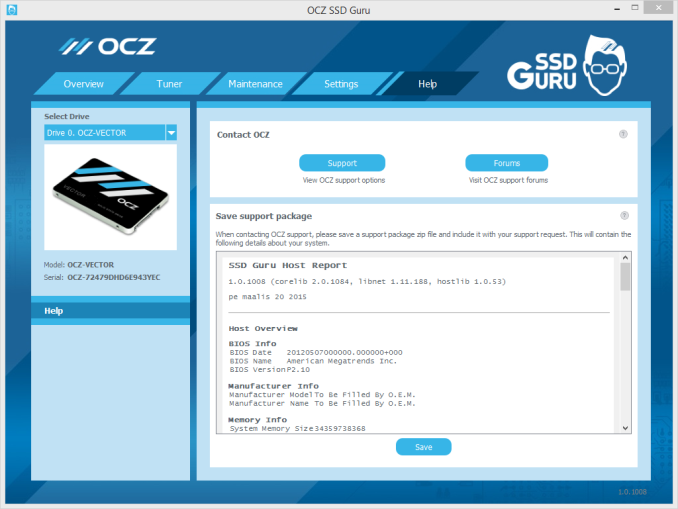
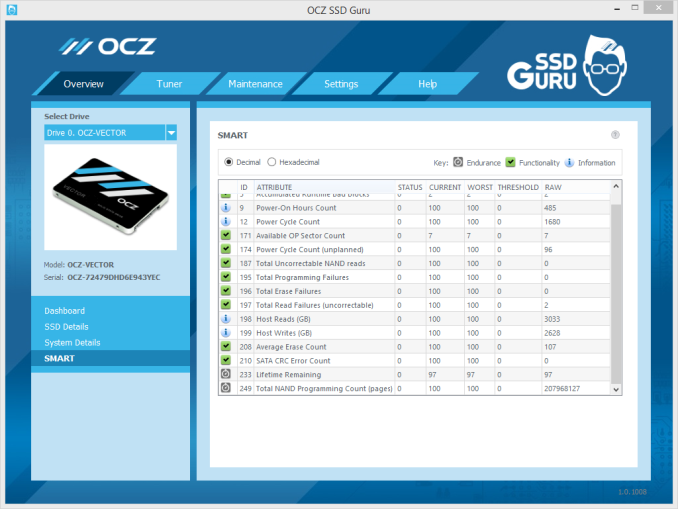








89 Comments
View All Comments
KAlmquist - Tuesday, March 24, 2015 - link
Vector 180 vx. MX 100:I think that the Crucial MX 100 will be a bit faster than the Vector 180 under typical usage, though the Vector 180 does outperform the MX 100 on some benchmarks. Both drives have partial power loss protection. The Vector 180 has a 5 year warranty vs. the 3 year warranty on the MX 100, but a lot of people will be looking to upgrade from SATA to PCIe SSD's before the 3 year warranty expires. In short, I don't see any reason to pay a premium price for the Vector 180.
MrCommunistGen - Tuesday, March 24, 2015 - link
If only HIPM+DIPM worked (yes I know its a hardware limitation of the platform) this looks like it'd be a great laptop SSD due to such low power consumption in the various workloads measured here.djsvetljo - Tuesday, March 24, 2015 - link
Two dead OCZ drives - there will never be a 3rd one. One of the drives was from the era of the bitcoins boom ( when they were easy to mine). Lost 150 coins there ( that's over $50 000). They stupid thing locked up due to power issues ( too many power cycles).STAY AWAY FROM OCZ
Antronman - Wednesday, March 25, 2015 - link
Well the thing is, the internals are drastically different right now.I've been in the market for a good SSD for a while. These drives seem to perform well. Sadly outperformed by the 850 Pro drives, but I do think that the enclosure is actually very aesthetically pleasing. If the cost could be driven down a lot, I'd be very interested in the 180.
mapesdhs - Wednesday, March 25, 2015 - link
You're right, they need to have a price advantage with the 180 to pull people in. Also,availability needs to be good - in the past it's been rather sketchy with the 150, which
means prices tend to creep up from a small number of suppliers.
Ian.
mapesdhs - Wednesday, March 25, 2015 - link
More than 30 OCZ drives, all working fine. Some had bad luck, others used Marvell portsand blame OCZ. It varies.
As for coins, well boohoo, not real money unless they're converted back to $.
Ian.
ocztosh - Monday, March 30, 2015 - link
Hi mapesdhs, thank you for your feedback and great to hear the drives are working well for you. We greatly appreciate both your business and support.FalcomPSX - Tuesday, March 24, 2015 - link
I've owned i think three OCZ drives in the past, they've all bricked on me within about a year. Never again will I purchase their shoddy products. While i was able to get warranty replacments each time, and the customer service is decent, the product itself is just not reliable in any way. I don't know if the new ones are improved at all, but i'm not risking MY data to find out.ocztosh - Wednesday, March 25, 2015 - link
Hello FalcomPSX, thank you for your comments and sorry to hear that you has a problem with previous drives. We are a new organization under Toshiba and have made significant changes to everything from processes to production. We understand how you feel and hope that one day we will have the opportunity to demonstrate the reliability of our current products. Thank you again for your feedbackNeatOman - Wednesday, March 25, 2015 - link
Battery backup should be built into the PSU for workstations and servers, google does this for their data centers.. why shouldn't servers and workstations. All you need is 1 minute for the average workstation to go into hibernation until power is back on IMO.